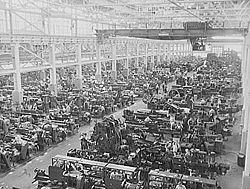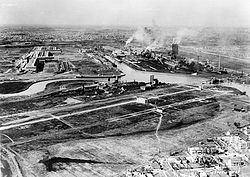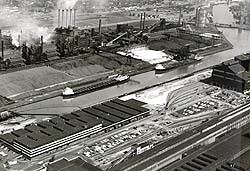Location Dearborn, Michigan NRHP Reference # 78001516 Designated MSHS December 14, 1976 Added to NRHP 2 June 1978 | Built 1917–1928 Designated NHLD June 2, 1978 Area 3.642 km² Architect Albert Kahn | |
Similar The Henry Ford, Ford Motor Company Highland, Fair Lane, Ford Piquette Avenue P, Ford Kansas City Asse | ||
The Ford River Rouge Complex (commonly known as the Rouge Complex or just The Rouge) is a Ford Motor Company automobile factory complex located in Dearborn, Michigan, along the Rouge River, upstream from its confluence with the Detroit River at Zug Island. Construction began in 1917, and when it was completed in 1928 it had become the largest integrated factory in the world. It served as an inspiration for the Russian GAZ factory in the 1930s, and the Hyundai factory complex in Ulsan, South Korea.
Contents
Structure

The Rouge measures 1.5 miles (2.4 km) wide by 1 mile (1.6 km) long, including 93 buildings with nearly 16 million square feet (1.5 km²) of factory floor space. With its own docks in the dredged Rouge River, 100 miles (160 km) of interior railroad track, its own electricity plant, and integrated steel mill, the titanic Rouge was able to turn raw materials into running vehicles within this single complex, a prime example of vertical-integration production. Over 100,000 workers were employed there in the 1930s.

Some of the Rouge buildings were designed by Albert Kahn. His Rouge glass plant was regarded at the time as an exemplary and humane factory building, with its ample natural light coming through windows in the ceiling. More recently, several buildings have been converted to "green" structures with a number of environmentally friendly features.

In the summer of 1932, through Edsel Ford's support, Diego Rivera studied the facilities at the Rouge; these studies became a major part of his set of murals Detroit Industry, on continuous display at the Detroit Institute of Arts since their completion in 1933.
Production

The Rouge's first products were Eagle Boats, World War I anti-submarine warfare boats produced in Building B. The original Building B, a three-story structure, is part of the legendary Dearborn Assembly Plant, which started producing Model A's in the late 1920s and continued production through 2004. After the war, production turned to Fordson tractors. Although the Rouge's coke ovens and foundry produced nearly all the parts of the Model T, assembly of that vehicle remained at Highland Park. It was not until 1927 that automobile production began there, with the introduction of the Ford Model A. Later Rouge products included the 1932 Model B, the original Mercury, the Ford Thunderbird, and four decades of Ford Mustangs. The old assembly plant was idled with the construction and launch of a new assembly facility on the Miller Road side of the complex, currently producing Ford F-150 pickup trucks.
The River Rouge Complex manufactured most of the components of Ford vehicles, starting with the Model T, where many of the vehicles were compiled into "knock-down kits", then sent by railroad to various assembly locations across the United States to be locally assembled, utilizing local labor and supplies as necessary. After the 1960s, Ford began to decentralize manufacturing, building several factories in major metropolitan centers. The Rouge, too, was downsized, with many units (including the famous furnaces and docks) sold off to independent companies.
On May 26, 1937, a group of workers attempting to organize a union at the Rouge were severely beaten, an event later called the Battle of the Overpass. Peter E. Martin's respect for labor led to Walter Reuther, a UAW leader, allowing Martin to be the only Ford manager to retrieve his papers or gain access to the plant.
By 1992, only Mustang production remained at the Dearborn Assembly Plant (DAP). In 1987 Ford planned to replace that car with the front wheel drive Ford Probe, but public outcry quickly turned to surging sales. With the fourth-generation Mustang a success, the Rouge was saved as well. Ford decided to modernize its operations. A gas explosion on February 1, 1999, killed six employees and injured two dozen more, resulting in the idling of the power plant. Michigan Utility CMS Energy built a state-of-the-art Power Plant across Miller Road to replace the electricity and steam production, as well as the Blast-Furnace waste gas consumption of the original power plant. As it ended production, Dearborn Assembly Plant (DAP) was one of six plants within the Ford Rouge Center. The plant was open from 1918 to May 10, 2004, with a red convertible 2004 Ford Mustang GT being the last vehicle built at the historic site. Demolition of the historic DAP facility was completed in 2008. All that remains is a 3000 place parking lot to hold light truck production from the new Dearborn Truck Plant.
Ford Rouge Center
Today, the Rouge site is home to Ford's Rouge Center. This industrial park includes six Ford factories on 600 acres (2.4 km²) of land, as well as steelmaking operations run by AK Steel, a U.S. steelmaker. The new Dearborn Truck factory famously features a vegetation-covered roof and rainwater reclamation system designed by sustainability architect William McDonough. This facility is still Ford's largest factory and employs some 6,000 workers. Mustang production, however, has moved to the Flat Rock Assembly Plant in Flat Rock, Michigan.
Tours of the factory were a long tradition. Tours of the facility began in 1924 and ran until 1980. They resumed in 2004 in cooperation with The Henry Ford Museum with multimedia presentations as well as viewing of the assembly floor.
The management of Dearborn Truck has decreed that no vehicles from other manufacturers may park at the front of the main employee lot. Non Ford Family vehicles are required to park in the back 12 rows of parking spaces. Hourly workers from both Ford and AK Steel facilities at the complex are represented by UAW Local 600.
Ford's SS William Clay Ford was based out of the River Rouge Plant.
Renovated architecture
In 1999 Architect William McDonough entered into an agreement with Ford Motor Company to redesign its 85-year-old, 1,212-acre (490 ha) Rouge River facility. The roof of the 1.1 million square foot (100,000 m2) Dearborn truck assembly plant was covered with more than 10 acres (4.0 ha) of sedum, a low-growing groundcover. The sedum retains and cleanses rainwater and moderates the internal temperature of the building, saving energy.
The roof is part of an $18 million rainwater treatment system designed to clean 20 billion U.S. gallons (76,000,000 m3) of rainwater annually, sparing Ford from a $50 million mechanical treatment facility.
